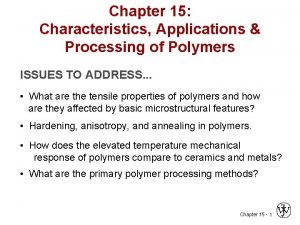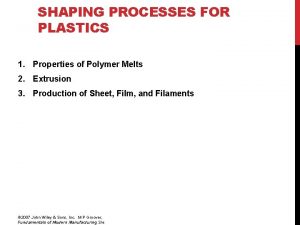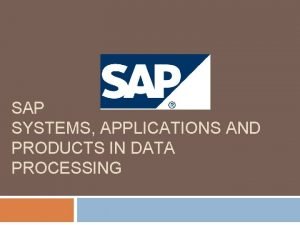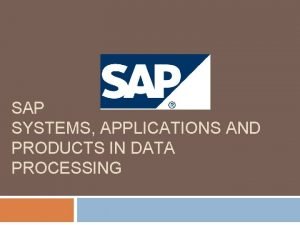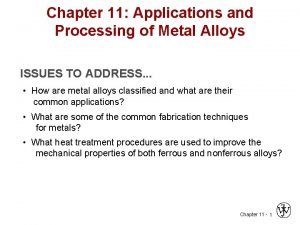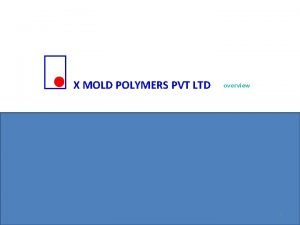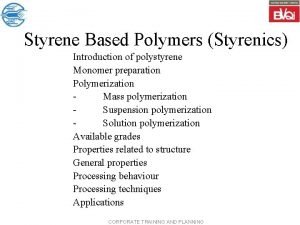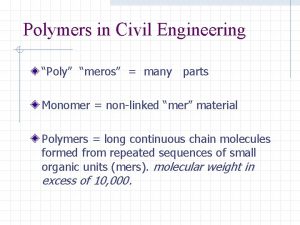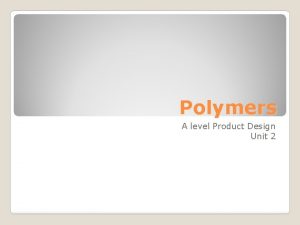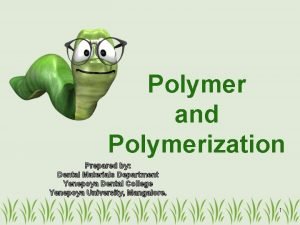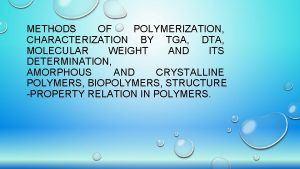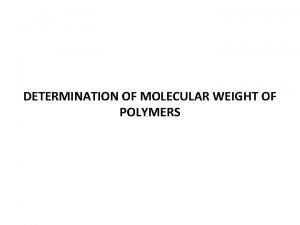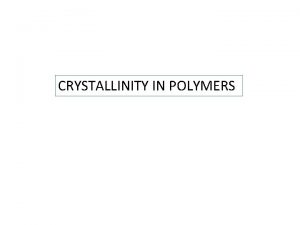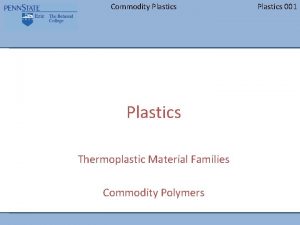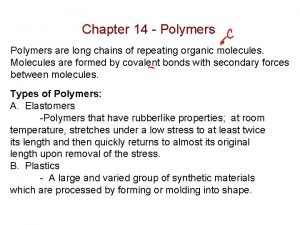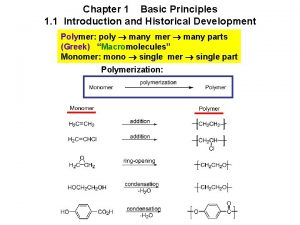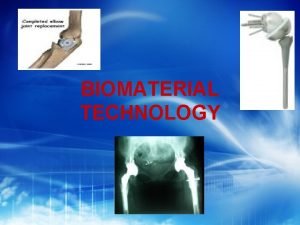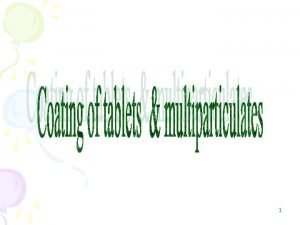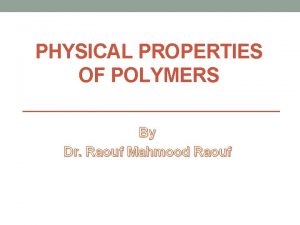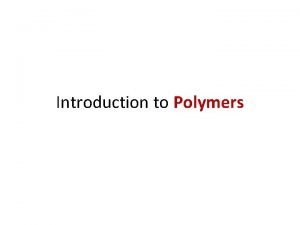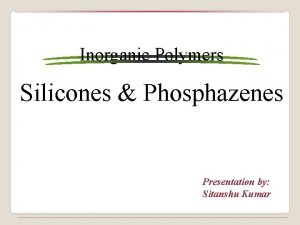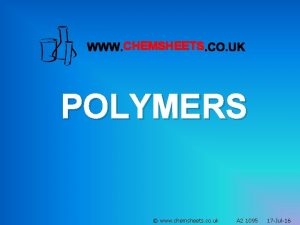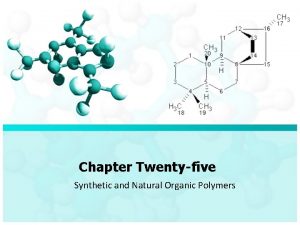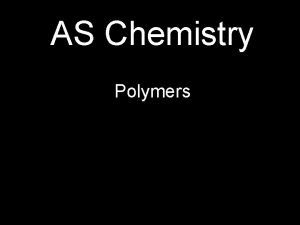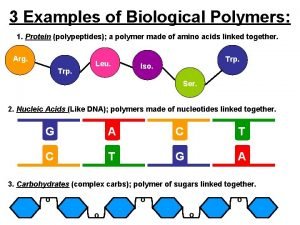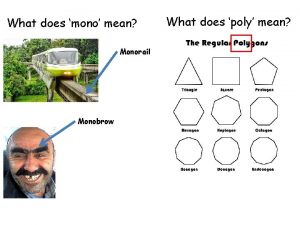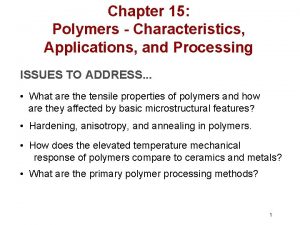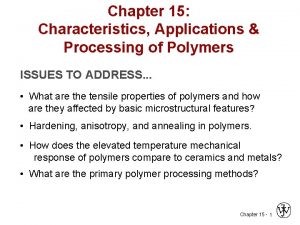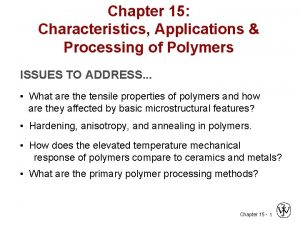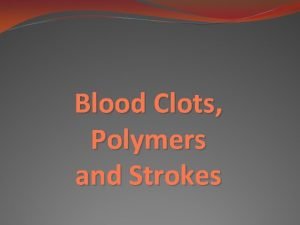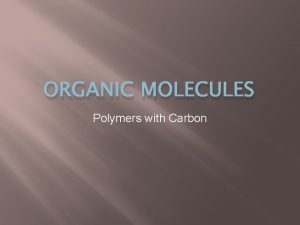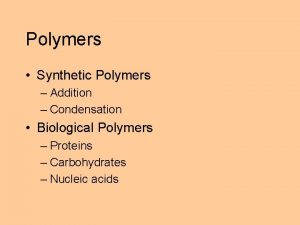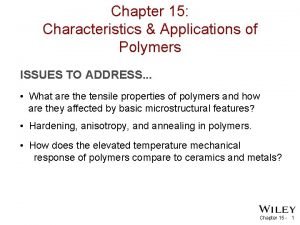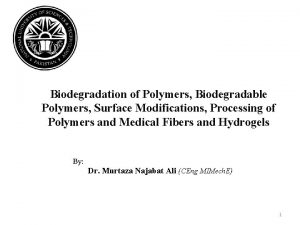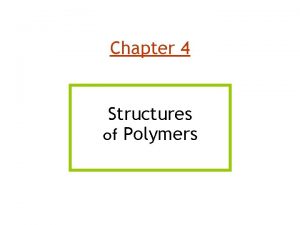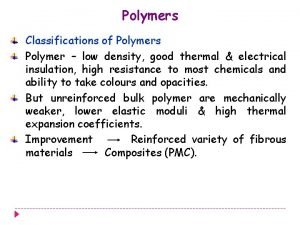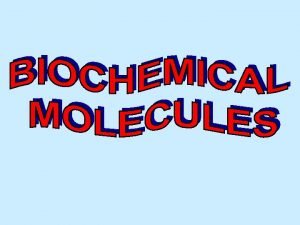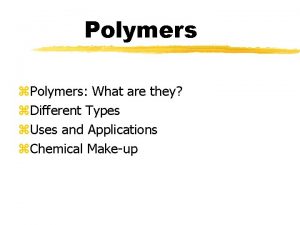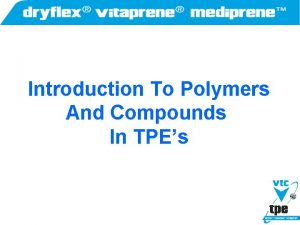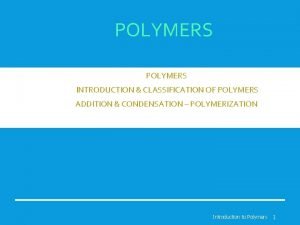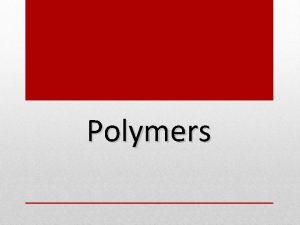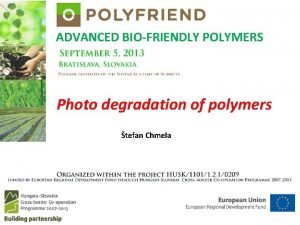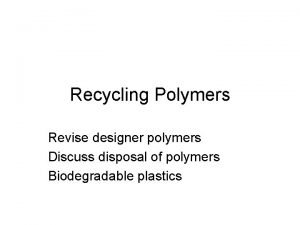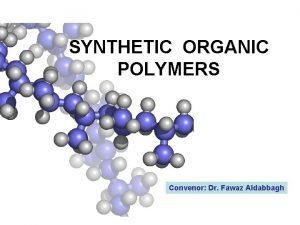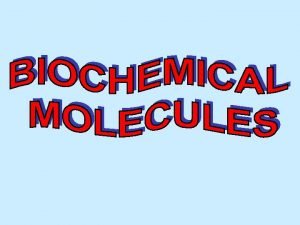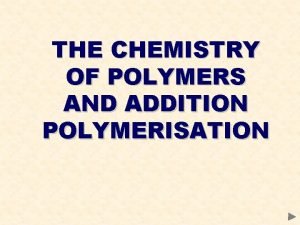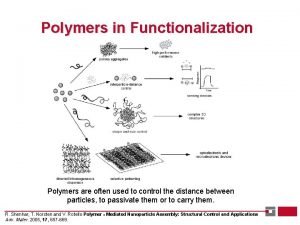Chapter 15 Characteristics Applications Processing of Polymers ISSUES




























- Slides: 28

Chapter 15: Characteristics, Applications & Processing of Polymers ISSUES TO ADDRESS. . . • What are the tensile properties of polymers and how are they affected by basic microstructural features? • Hardening, anisotropy, and annealing in polymers. • How does the elevated temperature mechanical response of polymers compare to ceramics and metals? • What are the primary polymer processing methods? Chapter 15 - 1

Mechanical Properties of Polymers – Stress-Strain Behavior brittle polymer plastic elastomer elastic moduli – less than for metals Adapted from Fig. 15. 1, Callister & Rethwisch 8 e. • Fracture strengths of polymers ~ 10% of those for metals • Deformation strains for polymers > 1000% – for most metals, deformation strains < 10% Chapter 15 - 2

Mechanisms of Deformation—Brittle Crosslinked and Network Polymers Initial Near Failure s(MPa) Initial x brittle failure Near Failure x plastic failure aligned, crosslinked polymer e network polymer Stress-strain curves adapted from Fig. 15. 1, Callister & Rethwisch 8 e. Chapter 15 - 3

Mechanisms of Deformation — Semicrystalline (Plastic) Polymers s(MPa) Stress-strain curves adapted from Fig. 15. 1, Callister & Rethwisch 8 e. Inset figures along plastic response curve adapted from Figs. 15. 12 & 15. 13, Callister & Rethwisch 8 e. (15. 12 & 15. 13 are from J. M. Schultz, Polymer Materials Science, Prentice. Hall, Inc. , 1974, pp. 500 -501. ) fibrillar structure x brittle failure onset of necking plastic failure x unload/reload e undeformed structure near failure amorphous regions elongate crystalline block segments separate crystalline regions align Chapter 15 - 4

Predeformation by Drawing • Drawing…(ex: monofilament fishline) -- stretches the polymer prior to use -- aligns chains in the stretching direction • Results of drawing: -- increases the elastic modulus (E) in the stretching direction -- increases the tensile strength (TS) in the stretching direction Adapted from Fig. 15. 13, Callister & Rethwisch 8 e. (Fig. 15. 13 is -- decreases ductility (%EL) from J. M. Schultz, Polymer Materials Science, Prentice-Hall, • Annealing after drawing. . . Inc. , 1974, pp. 500 -501. ) -- decreases chain alignment -- reverses effects of drawing (reduces E and TS, enhances %EL) • Contrast to effects of cold working in metals! Chapter 15 - 5

Mechanisms of Deformation— Elastomers s(MPa) x brittle failure x plastic failure elastomer x e initial: amorphous chains are kinked, cross-linked. final: chains are straighter, still cross-linked Stress-strain curves adapted from Fig. 15. 1, Callister & Rethwisch 8 e. Inset figures along elastomer curve (green) adapted from Fig. 15, Callister & Rethwisch 8 e. (Fig. 15 is from Z. D. Jastrzebski, The Nature and Properties of Engineering Materials, 3 rd ed. , John Wiley and Sons, 1987. ) deformation is reversible (elastic)! • Compare elastic behavior of elastomers with the: -- brittle behavior (of aligned, crosslinked & network polymers), and -- plastic behavior (of semicrystalline polymers) (as shown on previous slides) Chapter 15 - 6

Thermoplastics vs. Thermosets • Thermoplastics: -- little crosslinking -- ductile -- soften w/heating -- polyethylene polypropylene polycarbonate polystyrene • Thermosets: T viscous liquid mobile liquid crystalline solid Callister, rubber Fig. 16. 9 tough plastic partially crystalline solid Molecular weight Adapted from Fig. 15. 19, Callister & Rethwisch 8 e. (Fig. -- significant crosslinking 15. 19 is from F. W. Billmeyer, Jr. , Textbook of Polymer (10 to 50% of repeat units) Science, 3 rd ed. , John Wiley and Sons, Inc. , 1984. ) -- hard and brittle -- do NOT soften w/heating -- vulcanized rubber, epoxies, polyester resin, phenolic resin Chapter 15 - 7 Tm Tg

Influence of T and Strain Rate on Thermoplastics • Decreasing T. . . -- increases E -- increases TS -- decreases %EL • Increasing strain rate. . . -- same effects as decreasing T. s(MPa) 80 4ºC 60 20ºC 40 Plots for semicrystalline PMMA (Plexiglas) 40ºC 20 0 60ºC 0 0. 1 0. 2 e to 1. 3 0. 3 Adapted from Fig. 15. 3, Callister & Rethwisch 8 e. (Fig. 15. 3 is from T. S. Carswell and J. K. Nason, 'Effect of Environmental Conditions on the Mechanical Properties of Organic Plastics", Symposium on Plastics, American Society for Testing and Materials, Philadelphia, PA, 1944. ) Chapter 15 - 8

Melting & Glass Transition Temps. What factors affect Tm and Tg? • • • Both Tm and Tg increase with increasing chain stiffness Chain stiffness increased by presence of 1. Bulky sidegroups 2. Polar groups or sidegroups 3. Chain double bonds and aromatic chain groups Regularity of repeat unit arrangements – affects Tm only Adapted from Fig. 15. 18, Callister & Rethwisch 8 e. Chapter 15 - 9

Time-Dependent Deformation • Stress relaxation test: -- strain in tension to eo and hold. -- observe decrease in stress with time. tensile test eo • There is a large decrease in Er for T > Tg. 5 10 Er (10 s) 3 in MPa 10 rigid solid (small relax) transition region 1 10 10 -1 strain s(t) time • Relaxation modulus: viscous liquid 10 -3 (large relax) (amorphous polystyrene) Adapted from Fig. 15. 7, Callister & Rethwisch 8 e. (Fig. 15. 7 is from A. V. Tobolsky, Properties and Structures of Polymers, John Wiley and Sons, Inc. , 1960. ) 60 100 140 180 T(ºC) Tg • Representative Tg values ( C): PE (low density) PE (high density) PVC PS PC - 110 - 90 + 87 +100 +150 Selected values from Table 15. 2, Callister & Rethwisch 8 e. Chapter 15 - 10

Crazing During Fracture of Thermoplastic Polymers Craze formation prior to cracking – during crazing, plastic deformation of spherulites – and formation of microvoids and fibrillar bridges aligned chains fibrillar bridges microvoids crack Adapted from Fig. 15. 9, Callister & Rethwisch 8 e. Chapter 15 - 11

Polymer Formation • There are two types of polymerization – Addition (or chain) polymerization – Condensation (step) polymerization Chapter 15 - 12

Addition (Chain) Polymerization – Initiation – Propagation – Termination Chapter 15 - 13

Condensation (Step) Polymerization Chapter 15 - 14

Polymer Additives Improve mechanical properties, processability, durability, etc. • Fillers – Added to improve tensile strength & abrasion resistance, toughness & decrease cost – ex: carbon black, silica gel, wood flour, glass, limestone, talc, etc. • Plasticizers – Added to reduce the glass transition temperature Tg below room temperature – Presence of plasticizer transforms brittle polymer to a ductile one – Commonly added to PVC - otherwise it is brittle Chapter 15 - 15

Polymer Additives (cont. ) • Stabilizers – Antioxidants – UV protectants • Lubricants – Added to allow easier processing – polymer “slides” through dies easier – ex: sodium stearate • Colorants – Dyes and pigments • Flame Retardants – Substances containing chlorine, fluorine, and boron Chapter 15 - 16

Processing of Plastics • Thermoplastic – can be reversibly cooled & reheated, i. e. recycled – heat until soft, shape as desired, then cool – ex: polyethylene, polypropylene, polystyrene. • Thermoset – when heated forms a molecular network (chemical reaction) – degrades (doesn’t melt) when heated – a prepolymer molded into desired shape, then chemical reaction occurs – ex: urethane, epoxy Chapter 15 - 17

Processing Plastics – Compression Molding Thermoplastics and thermosets • polymer and additives placed in mold cavity • mold heated and pressure applied • fluid polymer assumes shape of mold Fig. 15. 23, Callister & Rethwisch 8 e. (Fig. 15. 23 is from F. W. Billmeyer, Jr. , Textbook of Polymer Science, 3 rd ed. , John Wiley & Sons, 1984. ) Chapter 15 - 18

Processing Plastics – Injection Molding Thermoplastics and some thermosets • when ram retracts, plastic pellets drop from hopper into barrel • ram forces plastic into the heating chamber (around the spreader) where the plastic melts as it moves forward • molten plastic is forced under pressure (injected) into the mold cavity where it assumes the shape of the mold Fig. 15. 24, Callister & Rethwisch 8 e. (Fig. 15. 24 is from F. W. Billmeyer, Jr. , Textbook of Polymer Science, 2 nd edition, John Wiley & Sons, 1971. ) Barrel Chapter 15 - 19

Processing Plastics – Extrusion thermoplastics • plastic pellets drop from hopper onto the turning screw • plastic pellets melt as the turning screw pushes them forward by the heaters • molten polymer is forced under pressure through the shaping die to form the final product (extrudate) Fig. 15. 25, Callister & Rethwisch 8 e. (Fig. 15. 25 is from Encyclopædia Britannica, 1997. ) Chapter 15 - 20

Processing Plastics – Blown-Film Extrusion Fig. 15. 26, Callister & Rethwisch 8 e. (Fig. 15. 26 is from Encyclopædia Britannica, 1997. ) Chapter 15 - 21

Polymer Types – Fibers - length/diameter >100 • Primary use is in textiles. • Fiber characteristics: – high tensile strengths – high degrees of crystallinity – structures containing polar groups • Formed by spinning – extrude polymer through a spinneret (a die containing many small orifices) – the spun fibers are drawn under tension – leads to highly aligned chains - fibrillar structure Chapter 15 - 22

Polymer Types – Miscellaneous • • Coatings – thin polymer films applied to surfaces – i. e. , paints, varnishes – protects from corrosion/degradation – decorative – improves appearance – can provide electrical insulation Adhesives – bonds two solid materials (adherands) – bonding types: 1. Secondary – van der Waals forces 2. Mechanical – penetration into pores/crevices • • Films – produced by blown film extrusion Foams – gas bubbles incorporated into plastic Chapter 15 - 23

Advanced Polymers Ultrahigh Molecular Weight Polyethylene (UHMWPE) • Molecular weight ca. 4 x 106 g/mol • Outstanding properties – – high impact strength resistance to wear/abrasion low coefficient of friction self-lubricating surface UHMWPE • Important applications – bullet-proof vests – golf ball covers – hip implants (acetabular cup) Adapted from chapteropening photograph, Chapter 22, Callister 7 e. Chapter 15 - 24

Advanced Polymers Thermoplastic Elastomers Styrene-butadiene block copolymer hard component domain styrene butadiene Fig. 15. 21(a), Callister & Rethwisch 8 e. soft component domain Fig. 15. 22, Callister & Rethwisch 8 e. (Fig. 15. 22 adapted from the Science and Engineering of Materials, 5 th Ed. , D. R. Askeland P. P. Phule, Thomson Learning, 2006. ) Chapter 15 - 25

Summary • Limitations of polymers: -- E, sy, Kc, Tapplication are generally small. -- Deformation is often time and temperature dependent. • Thermoplastics (PE, PS, PP, PC): -- Smaller E, sy, Tapplication -- Larger Kc -- Easier to form and recycle Table 15. 3 Callister & Rethwisch 8 e: • Elastomers (rubber): -- Large reversible strains! Good overview • Thermosets (epoxies, polyesters): of applications -- Larger E, sy, Tapplication and trade names -- Smaller Kc of polymers. Chapter 15 - 26

Summary • Polymer Processing -- compression and injection molding, extrusion, blown film extrusion • Polymer melting and glass transition temperatures • Polymer applications -- elastomers -- fibers -- coatings -- adhesives -- films -- foams -- advanced polymeric materials Chapter 15 - 27

ANNOUNCEMENTS Reading: Core Problems: Self-help Problems: Chapter 15 - 28
 Application and processing of polymers
Application and processing of polymers Characteristics of polymers
Characteristics of polymers Systems applications and products
Systems applications and products System application and products in data processing
System application and products in data processing Applications and processing of metal alloys
Applications and processing of metal alloys Xmold
Xmold Water soluble antiscalant polymers
Water soluble antiscalant polymers Abs plastic
Abs plastic Why do different polymers have different properties?
Why do different polymers have different properties? Disadvantages of thermoplastics
Disadvantages of thermoplastics Polymers product design
Polymers product design Polymeric dental materials
Polymeric dental materials Homochain polymers
Homochain polymers Osmometry molecular weight determination
Osmometry molecular weight determination Fringed micelle model
Fringed micelle model Commodity plastics
Commodity plastics Addition polymers 2 chemsheets
Addition polymers 2 chemsheets Structure of polymers
Structure of polymers Homochain polymers
Homochain polymers History of biomaterials
History of biomaterials Sugar coated tablet example
Sugar coated tablet example Typical properties of polymers
Typical properties of polymers Merester
Merester Silicones and phosphazenes
Silicones and phosphazenes Poly methyl 2-cyanopropenoate
Poly methyl 2-cyanopropenoate Synthetic organic polymers
Synthetic organic polymers Orlon monomer
Orlon monomer Polymer examples of proteins
Polymer examples of proteins What does mono mean
What does mono mean
